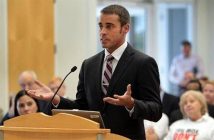
Illinois Gov. Bruce Rauner (R) has announced a newly established “Children’s Cabinet” for the purpose of improving the welfare of Illinois children.
Rauner made a stop at a school just outside Springfield to sign a governing mandate that established the “Governor’s Cabinet on Youth and Children.” The plan is to streamline education and other services of the state to assist young people, declared a press release from the office of the governor.
The 19 members of the cabinet would include the Secretary of Education Beth Purvis, directors of the governor’s Office of Management and Budget, and heads of state boards and agencies such as the Department of Employment Security and the Department of Juvenile Justice.
“The Governor’s Cabinet on Children and Youth is systematically addressing the fragmented system that currently exists in Illinois,” Purvis said in a press release. “Governor Rauner’s new structure will support and integrate the state’s priorities and initiatives more effectively to identify and address any agency collaboration barriers so we can more thoughtfully and aggressively improve the future for our children.”
Andy Grimm writes for the Chicago Sun-Times that there was no response from Rauner’s office when questioned about the cabinet’s priorities or how often they will convene. In the press release, goals of the cabinet included “creating a strategic vision” and “reducing bureaucracy.”
Since the mid-1990s, 17 other states have created such entities, notes Elizabeth Gaines, a policy expert for the Forum for Youth Investment, a Washington, D.C. nonprofit that manages a nationwide system of cabinets for youth. Gaines says she has spoken to the governor on several occasions.
She said that services for young people were addressed by many different agencies and departments, along with multiple budget sources. Cabinets have additional staff to make the collaboration happen, but the number of employees varies. Maryland’s cabinet has a staff of 2, while other states might have only one, Gaines added.
The governor says the ministry would bring all child-related agencies together to make them more useful. Purvis said the system as it is now is “fragmented,” reports The Associated Press.
Meanwhile, Rauner said in his Budget Address to a joint session of the Illinois General Assembly that he wants the lawmakers to approve a bill that will allow K-12 education funding to flow uninterrupted next school year, reports The Lincoln Courier’s Doug Finke.
The bill, he told the legislature, will include a $130 million raise for early childhood education and overall state aid to schools. Critics, however, were quick to point out that the governor left out how the increased spending would be paid when he has stated that Illinois has spending needs that are much larger than the tax revenues coming in.
The foundation level of per-pupil funding is $6,119 in Illinois, but schools are only getting approximately 92% of what they should be receiving. Rauner wants to ensure that the school aid formula is revised so that more money can be directed to poorer school districts.
Sen. Andy Manar (D-Bunker Hill) has worked over two years on school funding reform and said the governor’s proposal is doomed to fail because finding a formula that a majority will agree on is not possible. Taking money from one school district and distributing it to another will never work, he explained.
Rauner presented his Turnaround Agenda, which is a multiple step proposal to turn Illinois into a “growth state.” Measures include phasing in a minimum wage raise of 25 cents every year for the next seven years, writes Alexander Chettiath of the Northern Star.
Community members, faculty, and hundreds of students from eight of Illinois’ public universities gathered at the state capitol last Wednesday to urge the governor and lawmakers to put an end to an eight-month budget battle and renew FY2016 funding for higher education grants and programs.
This demonstration had nothing to do with monies for the next academic year since the rally was concerned with money that should have been available last July for the school year.
Court-ordered mandates have released much of the FY2016 appropriations, but higher education funding remains incomplete. Opponents say the governor is using the college funds issues as leverage to get the Democratic-controlled General Assembly to pass his Turnaround Agenda.
Eastern Illinois University laid off 198 faculty and staff members last week, and according to the Chicago Tribune reported that Chicago State University will have no money on March 1.
Colby Bermel, reporting for USA Today, quoted senior Charles Preston, the leader of a group from Chicago State University:
“I’m not sure what happens on March 1. We might close, we might not; it’s uncertain. My mother works at this school, and I’m a senior trying to graduate. I can’t fathom it.”




